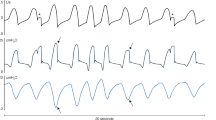Abstract
The CO2, O2, and N2 gradients between alveolar air and arterial blood were measured during a mild steady-state exercise test in three groups of non-smoking men, 20–29, 40–49, and 63–70 years old, respectively. Breathing a low O2-mixture (15.8% O2) the (a-A) D CO2 and the (a-A) D N2 decreased during exercise, compared to room air breathing, when the same exercise level was imposed, indicating a more homogeneous distribution of alveolar ventilation and perfusion under the influence of hypoxia. However, the (A-a) D O2 remained constant during both conditions, i. e. room air and hypoxia breathing. It is well known that the O2 gradient increases under both conditions with age. The failure to demonstrate an (a-A) D N2 when a large (A-a) D O2 is present, suggests the presence of large compartments of the lungs with a low diffusion/perfusion relation (rarification of capillaries and a relatively high number of shortly segmented capillaries). The low diffusion/perfusion regions seem to contribute much more to the large (A-a) D O2 than do the less important low ventilation/perfusion compartments. Such a constellation of maldistibution between alveolar ventilation, diffusion, and perfusion seems to be characteristic for the aging lung of non-smokers performing mild exercise.
Similar content being viewed by others
References
Asmussen, E., Nielsen, M.: Alveolo-arterial gas exchange at rest and during work at different O2-tensions. Acta Physiol. Scand.50, 153 (1960)
Bachofen, H., Hobi, H. J., Scherrer, M.: Alveolar-arterial N2 gradients at rest and during exercise in healthy men of different ages. J. Appl. Physiol.34, 137 (1973)
Bitter, H. S., Rahn, H.: Studies in Respiratory Physiology. WADC, p. 466. Technical Report 1956
Bitterli, J., Bachofen, H., Kyd, K., Scherrer, M.: Repeated measurements of pulmonary O2-diffusing capacity in man during graded exercise. p. 139. In: Scherrer, M.: Pulmonary diffusing capacity on exercise. Huber, Bern-Stuttgart-Wien 1971
Canfield, R. E., Rahn, H.: Arterial-alveolar N2 Gas Pressure Differences due to ventilation-perfusion variation. J. Appl. Physiol.10, 165 (1957)
Craig, D. B., Wahba, W. M., Don, H. F., Couture, J. G., Becklake, M. R.: “Closing volume” and its relationship to gas exchange in seated and in supine positions. J. Appl. Physiol.31, 717 (1971)
Dugard, A., Naimark, A.: Effect of hypoxia on distribution of pulmonary blood flow. J. Appl. Physiol.23, 663 (1967)
Eichna, L. W., Berge, A. R., Rader, B., Becker, W. H.: Comparison of intracardiac and intravascular temperatures with rectal temperatures in man. J. Clin. Invest.30, 353 (1951)
Farhi, L. E.: Ventilation-perfusion relationship and its role in alveolar gas exchange Advances of Respiratory Physiology. Arnold, London 1966
Fleisch, A.: Nouvelles Méthodes d'Etudes des Exchanges Gazeux et de la Fonction Pulmonaire. Schwabe, Basel 1954
Groom, A. C., Morin, R., Farhi, L. E.: Determination of dissolved N2 in blood and investigation of N2 washout from the body. J. Appl. Physiol.23, 706 (1967)
Hart, M. C., Orzales, M. M., Cook, C. D.: Relation between anatomic respiratory dead space and body size and lung volume. J. Appl. Physiol.18, 519 (1963)
Hedley-Whyte, J., Radford, E. P., Jr., Laver, M. B.: Nomogram for temperature correction or electrode calibration during pO2 measurements. J. Appl. Physiol.20, 785 (1965)
Holley, H. S., Milic-Emili, J., Becklake, M. R., Bates, D. V.: Regional distribution of pulmonary ventilation and perfusion in obesity. J. Clin. Invest.46, 475 (1967)
Hyde, R. W., Forster, R. E., Power, G. G., Nairns, J., Rynes, R.: Measurement of O2 diffusing capacity of the lungs with a stable O2 Isotope. J. Clin. Invest.45, 1178 (1966)
Hyde, R. W., Rynes, R., Power, G. G., Nairns, J.: Determination of distribution of diffusing capacity in relation to blood flow in the human lung. J. Clin. Invest.46, 463 (1967)
King, T. K. C., Briscoe, W. A.: Bohr integral isopleths in the study of blood gas exchange in the lung. J. Appl. Physiol.22, 659 (1967)
Lenfant, C.: Measurement of ventilation/perfusion distribution with alveolar-arterial differences. J. Appl. Physiol.18, 1090 (1963)
Nielsen, B., Nielsen, M.: Body temperature during work at different environmental temperature. Acta Physiol. Scand.56, 120 (1962)
Piiper, J., Haab, P., Rahn, H.: Unequal distribution of pulmonary diffusing capacity in the anesthetized dog. J. Appl. Physiol.16, 499 (1960)
Rahn, H., Fenn, W. O.: The oxygen-carbon dioxide diagram. WADC, p. 14/15. Technical Report 1953
Rahn, H., Farhi, L. E.: Ventilation, perfusion, and gas exchange. The VA/Q concept. Handbook of Physiology, Respiration. sct. 3, vol. I, chapt. 30, p. 735. Washington DC: Am. Physiol. Soc., 1964
Riley, R. L., Cournand, A.: “Ideal” alveolar air and analysis of ventilation perfusion relationships in the lungs. J. Appl. Physiol.1, 825 (1948)
Ruff, F., Housley, E., Craig, D., Don, H., Becklake, M., Milic-Emili, J., Couture, J.: Airway closure and (A-a) D O2 in man. Proc. Internat. Union Physiol. Sci.9, 123 (1971)
Scherrer, M., Birchler, A.: Altersabhängigkeit des alveolo-arteriellen O2-Partialdruck-gradienten bei schwerer Arbeit in Normoxie, Hypoxie und Hyperoxie. Med. Thoracalis24, 99 (1967)
Scherrer, M., Haslimeier, P.: Alveolärer O2-Druck und O2-Diffusionskapazität. Schweiz. med. Wschr.98, 1282, 1968.
Severinghaus, J. W.: Blood gas concentrations. In: Handbook of Physiology. Respiration. sect. 3, vol. II, ch. 61, p. 1475–1487. Washington, DC: Am. Physiol. Soc., 1965
Sorbini, C. A., Grassi, V., Solinas, E., Muiesan, G.: The arterial oxygen tension in relation to age in healthy subjects. Respiration25, 1 (1968)
Thews, G., Witte, K.: Der Einfluß statistisch verteilter ungleicher O2-Diffusionswiderstände der Lungenmembran auf die O2-Diffusionskapazität. Beitr. Silikose-Forsch. Sonderband5, 329 (1963)
West, J. B., Dollery, C. T.: Distribution of blood flow and ventilation-perfusion ratio in the lung measured with radio-active CO2. J. Appl. Physiol.15, 405 (1960)
Witschi, H. P., Scherrer, M.: Bedeutung und Messung des alveolären Totraumes. Helv. Med. Acta27, 155 (1960)
Young, A. C.: Dead space at rest and during exercise. J. Appl. Physiol.8, 91 (1953)
Author information
Authors and Affiliations
Rights and permissions
About this article
Cite this article
Scherrer, M. The CO2, O2, and N2 gradients between alveolar air and arterial blood during steady-state exercise in healthy non-smoking young and elderly men at normoxia and at hypoxia. Pneumologie 151, 233–240 (1974). https://doi.org/10.1007/BF02095389
Received:
Issue Date:
DOI: https://doi.org/10.1007/BF02095389




